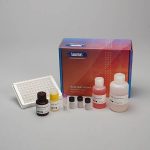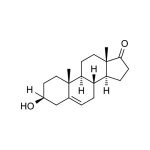Diagnostic Salivary DHEA ELISA Kit (CE Mark)
| Specifications |
|
Catalog#: |
1-2212 |
|
Regulatory Status: |
CE Mark |
|
Format: |
96-well plate |
|
Assay Time: |
~ 4 hrs |
|
Sample Volume/Test: |
50 µL |
|
Sensitivity: |
5 pg/mL |
|
Assay Range: |
10.2 pg/mL - 1000 pg/mL |
|
Storage Requirements: |
2-8°C |
| Tests Per Kit |
|
Singlet: |
76 |
|
Duplicate: |
38 |
References & Salivary DHEA Research
-
- Kroboth, P.D., Salek, F.S., Pittenger, A.L., et al. (1999). DHEA and DHEA-S: A review. J Clin Pharmacol, 39(4), 327-48.
- Labrie, F. (2010). DHEA, important source of sex steroids in men and even more in women. Prog Brain Res, 182, 97-148.
- Labrie, F., Bélanger, A., Cusan, L., Candas, B. (1997). Physiological changes in dehydroepiandrosterone are not reflected by serum levels of active androgens and estrogens but of their metabolites: Intracrinology. J Clin Endocrinol Metab, 82(8), 2403-9.
- Labrie, F., Luu-The, V. Bélanger, A., et al. (2005). Is dehydroepiandrosterone a hormone? J Endocrinol, 187, 169-96.
- Maninger, N., Wolkowitz, O.M., Reus, V.I., et al. (2009). Neurobiological and neuropsychiatric effects of dehydroepiandrosterone (DHEA) and DHEA sulfate (DHEAS). Front Neuroendocrinol, 30(1), 65-91.
- Dillon, J.S. (2005). Dehydroepiandrosterone, dehydroepiandrosterone sulfate and related steroids: Their role in inflammatory, allergic and immunological disorders. Curr Drug Targets Infl Allergy, 4(3), 377-85.
- Widstrom, R., Dillon, J.S. (2004). Is there a receptor for dehydroepiandrosterone or dehydroepiandrosterone sulfate? Semin Repro Med, 22(4), 289-98.
- Baulieu, E.-E., Robel, P. (1998). Dehydroepiandrosterone (DHEA) and dehydroepiandrosterone sulfate (DHEA) as neuroactive neurosteroids. Proc Natl Acad Sci U S A, 95(8), 4089-91.
- Charalampopoulos, I., Alexaki, V.-I., Tsatsanis, C., et al. (2006). Neurosteroids as endogenous inhibitors of neuronal cell apoptosis in aging. Ann N Y Acad Sci, 1088, 139-52.
- Izawa, S. Sugaya, N., Shirotsuki, K., et al. (2008). Salivary dehydroepiandrosterone secretion in response to acute psychosocial stress and its correlations with biological and psychological changes. Biol Psych, 79(3), 294-98.
-
- Goodyer, I.M., Herbert, J., Altham, P.M., et al. (1996). Adrenal secretion during major depression in 8- to 16-year-olds, I. Altered diurnal rhythms in salivary cortisol and dehydroepiandrosterone (DHEA) at presentation. Psychol Med, 26(2), 245-56.
- Young, A.H., Gallagher, P., Porter, R. (2002). Elevation of the cortisol-dehydroepiandrosterone ratio in drug-free depressed patients. Am J Psychiatry, 159(7), 1237-39.
- Harris, D.S., Wolkowitz, O.M., Reus, V.I. (2001). Movement disorder, memory, psychiatric symptoms and serum DHEA levels in schizophrienic and schizoaffective patients. World J Biol Psychiatry, 2(2), 99-102.
- Christeff, N., Gherbi, N., Mammes, O., et al. (1997). Serum cortisol and DHEA concentrations during HIV infection. Psychoneuroendocrinology, 22 (Suppl. 1), S11-18.
- Rosenfeld, R.S., Rosenberg, B.J., Fukushima, D.K., Hellman, L. (1975). 24-Hour secretory pattern of dehydroisoandrosterone and dehydroisoandrosterone sulfate. J Clin Endocrinol Metab, 40(5), 850-5.
- Longcope, C. (1995). Metabolism of dehydroepiandrosterone. Ann N Y Acad Sci, 774, 143-48.
- Simon, J.A. (2002). Estrogen replacement therapy: Effect on the endogenous androgen milieu. Fertil Steril, 77 (Suppl 4), S77-82.)
- Vining, R.F., McGinley, R.A., Symons, R.G. (1983). Hormones in saliva: Mode of entry and consequent implications for clinical interpretation. Clin Chem, 29(10), 1752-56.
- Shirtcliff, E.A., Granger, D.A., Schwartz, E., Curran, M.J. (2001). Use of salivary biomarkers in biobehavioral research: Cotton-based sample collection methods can interfere with salivary immunoassay results. Psychoneuroendocrinology, 26(2), 165-73.)

 Contact: Salimetrics (USA)
Contact: Salimetrics (USA)
